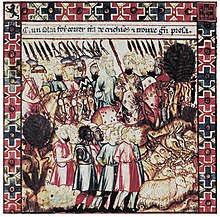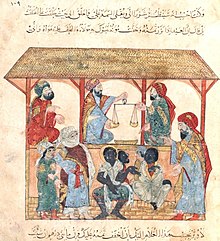Slavery in medieval Europe
As European kingdoms transitioned to feudal societies, a different legal category of unfree persons – serfdom – began to replace slavery as the main economic and agricultural engine.
Throughout medieval Europe, the perspectives and societal roles of enslaved peoples differed greatly, from some being restricted to agricultural labor to others being positioned as trusted political advisors.
[8] About ten percent of England's population entered in the Domesday Book (1086) were slaves,[9] despite chattel slavery of English Christians being nominally discontinued after the 1066 conquest.
[11][12][13] Arabic silver dirhams, presumably exchanged for slaves, are plentiful in eastern Europe and Southern Sweden, indicating trade routes from Slavic to Muslim territory.
[17] By the reign of Pope Zachary (741–752), Venice had established a thriving slave trade, enslaving people in Italy, among other places, and selling them to the Moors in North Africa (Zacharias himself reportedly forbade such traffic out of Rome).
They sold both Baltic and Slavic slaves, as well as Armenians, Circassians, Georgians, Turks and other ethnic groups of the Black Sea and Caucasus, to the Muslim nations of the Middle East.
[23] Genoa primarily managed the slave trade from Crimea to Mamluk Egypt, until the 13th century, when increasing Venetian control over the Eastern Mediterranean allowed Venice to dominate that market.
Ibn Hawqal, Ibrahim al-Qarawi, and Bishop Liutprand of Cremona note that the Jewish merchants of Verdun specialized in castrating slaves, to be sold as eunuch saqaliba, which were enormously popular in Muslim Spain.
Raids on al-Andalus by Vikings are reported in the years 844, 859, 966, and 971, conforming to the general pattern of such activity concentrating in the mid ninth and late tenth centuries.
Scandinavian trade centers stretched eastwards from Hedeby in Denmark and Birka in Sweden to Staraya Ladoga in northern Russia before the end of the 8th century.
[45] Ahmad ibn Fadlan of Baghdad provides an account of the other end of this trade route, namely of Volga Vikings selling Slavic slaves to middle-eastern merchants.
[76] The ancient and medieval Near East includes modern day Turkey, the Levant and Egypt, with strong connections to the rest of the North African coastline.
[90] It was the Fatimids who first incorporated black professional slave soldiers into the cavalry, despite massive opposition from Central Asian Turkish Mamluks, who saw the African contingent as a threat to their role as the leading military unit in the Egyptian army.
[90]In the later half of the Middle Ages, the expansion of Islamic rule further into the Mediterranean, the Persian Gulf, and Arabian Peninsula established the Saharan-Indian Ocean slave trade.
There are references to gangs of slaves, mostly African, put to work in drainage projects in Iraq, salt and gold mines in the Sahara, and sugar and cotton plantations in North Africa and Spain.
[100] In the devşirme (translated "blood tax" or "child collection"), young Christian boys from Anatolia and the Balkans were taken away from their homes and families, converted to Islam and enlisted into special soldier classes of the Ottoman army.
Due to manumission being a form of piety under Islamic law, slavery in Muslim Spain couldn't maintain the same level of auto-reproduction as societies with older slave populations.
[113][114] Forming relations between the Umayyads, Khārijites and 'Abbāsids, the flow of trafficked people from the main routes of the Sahara towards Al-Andalus[115] served as a highly lucrative trade configuration.
Additionally, it demonstrates profound change from one regional entity to another, the direct transfer of people and pure coinage from one religiously similar semi-autonomous province to another.
From the fifth to the early 8th century, large portions of the Iberian Peninsula were ruled by Christian Visigothic Kingdoms, whose rulers worked to codify human bondage.
Slavery remained persistent in Christian Iberia after the Umayyad invasions in the 8th century, and the Visigothic law codes continued to control slave ownership.
A letter from Pope Gregory XI to the Bishop of Cordoba in 1239 addressed rumors that the Jews were involved in kidnapping and selling Christian women and children into slavery while their husbands were away fighting the Muslims.
[144] The sale of Muslim captives, either back to the Islamic southern states or to third-party slave brokers, supplied one of the means by which Aragon and Castile financed the Reconquista.
Additionally, religious division was the fundamental basis of law for the ownership of slaves during this period; it was not legal for Christians, Muslims, or Jewish people to enslave fellow believers.
[156] While it is possible that some Romani people were slaves or auxiliary troops of the Mongols or Tatars and Nogai Horde, the bulk of them came from south of the Danube at the end of the 14th century, some time before the foundation of Wallachia.
During the period that slavery was disappearing across most of western Europe, it was reaching its height in the British Isles: with the Viking invasions and the subsequent warring between Scandinavians and the natives, the number of captives taken as slaves drastically increased.
The Irish church was vehemently opposed to slavery and blamed the 1169 Norman invasion on divine punishment for the practice, along with local acceptance of polygyny and divorce.
[174] Pierre Bonnassie, a medieval historian, thought that the chattel slavery of the ancient world ceased to exist in the Europe of the 10th century and was followed by feudal serfdom.
Some think that slavery was the exclusion of people from the public sphere and its institutions, whereas serfdom was a complex form of dependency that usually lacked a codified basis in the legal system.
Muslim sources in the 7th century allude to the Curse of Ham gaining relevance as a justifying myth for the Islamic world's longstanding enslavement of Africans.














